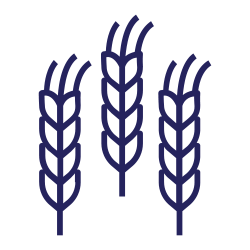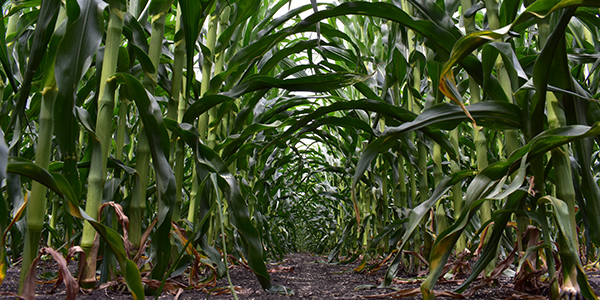Section Title
Fungicide Management of Fusarium Head Blight in Cereals
Crop Types
- Wheat
- Winter Wheat
Managing Fusarium head blight (FHB) in cereals can be very challenging. While newer varieties of wheat and barley have improved resistance to FHB, varieties that are completely resistant remain elusive. To add an additional challenge, currently available fungicides provide suppression but not control of FHB and must be applied during a narrow spray window.
When planning your strategy for managing FHB with fungicides, the process can be broken down into four considerations: whether fungicide is necessary, which fungicide to apply, when to apply fungicide, and what spray technologies to use to maximize efficacy.
Decision to spray
When deciding whether to spray, it is helpful to consider the disease triangle, which explains that disease development requires the presence of a susceptible host, a virulent pathogen and favourable environmental conditions.

Figure 1: The “disease triangle.”
High humidity, frequent rainfall and warm temperatures all increase the risk of FHB infection. From the beginning of winter wheat flowering to the end of spring wheat flowering, Manitoba Agriculture releases daily Fusarium Head Blight Risk Maps. These maps are based on a model that takes temperature and hours of precipitation into consideration, so they show risk based on the environment. If periods of heat and humidity occur when your crop is at the most susceptible stages (i.e., from head emergence to the end of flowering), especially if your cereal variety has limited resistance to FHB, fungicide may be beneficial.
Fungicide
When choosing a fungicide, it is important to remember that currently available fungicides provide suppression, not control of FHB. Until recently, the only fungicide group registered for suppression of FHB was Group 3. These products have been widely studied and many active ingredients within this group have been shown to effectively suppress both FHB and DON 1–5. Several products are now available that are mixes of active ingredients from two fungicide groups.
For a complete guide to foliar fungicides available for the suppression of FHB in cereals, consult the Manitoba Agriculture Guide to Field Crop Protection. Farmers can also consult the Keep It Clean Product Advisory for market risks and maximum residue limits associated with fungicides in cereals.
Spray timing
While cereal crops can be infected by FHB from head emergence to the soft dough stage, they are most susceptible from flowering (anthesis) to milk stage. To effectively protect the developing head, fungicides must be applied at the correct time. Once symptoms of FHB are observed, it is too late.
Since the correct time to apply fungicide is described relative to flowering, this raises the question: how do we tell when a cereal is flowering? In this respect, wheat and barley differ slightly. Barley flowers while the head is still in the boot and as it emerges. In contrast, wheat flowers after the head has completely emerged from the boot. In wheat, flowering begins when small yellow “anthers” emerge from the middle of the head. As flowering progresses, anthers will continue to emerge up and down the head, eventually turning white and falling off. Across an entire field, the progression of flowering will be variable. An entire wheat field is considered to be at flowering when 50 per cent of heads on the main stem are flowering.

Figure 2: A wheat head undergoing flowering.
Due to the differences in the way they flower, the recommended timing for fungicide application differs slightly between wheat and barley:
- Wheat: Most fungicides approved for suppression of FHB recommend that application take place from the time when at least 75 per cent of wheat heads on the main stem are fully emerged to when 50 per cent of the heads on the main stem are in flower.
- Barley: Most fungicides approved for suppression of FHB recommend that application take place from when 70-100 per cent of heads on the main stem are fully emerged to three days after full head emergence.
However, weather and field conditions do not always allow for spraying during these relatively short windows. If application at anthesis (for wheat) or at full head emergence (for barley) is not possible, the next best option is to apply fungicide after these windows, rather than before. In wheat, research has shown that the fungicide maintains effectiveness when applied until about seven days after anthesis 4,6. In barley, later applications (seven to 10 days after head emergence) can still reduce DON levels (Turkington et al., unpublished).
When making decisions on the timing of fungicide applications, always read and follow the label regarding pre-harvest intervals.
Spray technology
When considering what fungicide application methods to use to maximize efficacy, it is important to remember that FHB infects the head of the plant, so the fungicide must be present on the head. This means that unlike many other situations, fungicide applications for FHB have a vertical target. There are a few actions that can be taken to maximize efficacy:
- Dual-angled spray nozzles: Many studies have shown that angled sprays provide better coverage to wheat heads. Nozzles with backward-pointing sprays at a steep angle can help maximize spray coverage on both sides of the wheat head.
- Coarse sprays: When using angled sprays, the evaporation of fine droplets becomes a larger issue. Coarse sprays evaporate more slowly and are less likely to be blown off course by wind.
- Low boom heights (and slower travel speed): Using a lower boom height (less than 24 inches above the highest wheat heads) can also help maximize spray coverage when using angled sprays. Reducing travel speed can help maintain lower boom heights.
- Water volume: Most fungicides approved for suppression of FHB require a minimum water volume of 40 L/ac. When possible, using higher water volumes will help maximize coverage.
For more information on this topic, the not-for-profit website Sprayers101 by Jason Deveau and Tom Wolf is an excellent resource for information on how to best apply pesticides.
Fungicide-resistance considerations
Repeated use can cause the Fusarium pathogen to become less sensitive to a fungicide or other fungicides within the same group. While a recent study has shown that populations of the Fusarium pathogen in Western Canada do not have reduced sensitivity to Group 3 fungicides, reduced sensitivity to these fungicides has been reported in the United States 7. To delay the development of fungicide resistance, several management practices are available to farmers:
- Fungicide rotation: When possible, rotate the use of active ingredients within and between fungicide groups. Until recently, the only fungicide group registered for use on FHB was Group 3. Several products are now available that are mixes of active ingredients from two groups.
- Maximum number of applications: Do not apply more than the maximum number of applications per season listed on the product label and avoid spraying other fungicides within the same group.
- Follow the label: Always follow the product label and apply fungicides at the recommended rates and times.
- Integrated pest management (IPM): Use of fungicides should be part of an IPM program. This may include:
- Scouting to schedule fungicide application and minimize unnecessary use.
- Consulting local weather and FHB forecasts to determine risk.
- Production practices to reduce risk, such as crop rotation and planting less susceptible varieties.
Managing FHB in cereals can be challenging. Set yourself up for success by incorporating IPM strategies. When fungicides are necessary, maximize efficacy by spraying at the right time and using the most effective spray methods.
This article is intended to serve as a general guide with recommendations for getting the most out of your fungicides. Always read and follow the fungicide label, which will include details and precautions specific to each product.
Additional resources
Manitoba Crop Alliance
Alberta Wheat and Barley Commissions
- In the Field Webinar – The mechanics of Fusarium head blight fungicide application with Dr. Tom Wolf
Sprayers101
Manitoba Agriculture
- Dealing with Fusarium Head Blight
- Managing Fusarium Head Blight at Harvest
- Scouting and Control of Fusarium Head Blight in Wheat and Barley
Purdue Extension
References
- Amarasinghe, C. C., Tamburic-Ilincic, L., Gilbert, J., Brûlé-Babel, A. L. & Dilantha Fernando, W. G. Evaluation of different fungicides for control of fusarium head blight in wheat inoculated with 3ADON and 15ADON chemotypes of Fusarium graminearum in Canada. Can. J. Plant Pathol. 35, 200–208 (2013).
- Paul, P. A. et al. Meta-Analysis of the Effects of QoI and DMI Fungicide Combinations on Fusarium Head Blight and Deoxynivalenol in Wheat. Plant Dis. 102, 2602–2615 (2018).
- Paul, P. A. et al. Efficacy of Triazole-Based Fungicides for Fusarium Head Blight and Deoxynivalenol Control in Wheat : A Multivariate Meta-Analysis. Phytopathology 98, 999–1011 (2008).
- Singh, G., Hnatowich, G., Peng, G. & Kutcher, H. R. Fungicide Mitigates Fusarium Head Blight in Durum Wheat When Applied as Late as the End of Flowering in Western Canada. Plant Dis. 105, 3481–3489 (2021).
- Singh, L. et al. Evaluation of Application Timing of Miravis Ace for Control of Fusarium Head Blight in Wheat. Plant Heal. Prog. 22, 94–100 (2021).
- Paul, P. A. et al. Effects of Pre- And Postanthesis Applications of Demethylation Inhibitor Fungicides on Fusarium Head Blight and Deoxynivalenol in Spring and Winter Wheat. Plant Dis. 102, 2500–2510 (2018).
- Singh, G. Improving Fusarium Head Blight Managment in Durum Wheat in Saskatchewan. PhD Thesis. (University of Saskatchewan, 2021).












